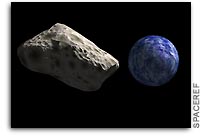An asteroid big enough to obliterate Britain and devastate a continent COULD be on a collision course with earth, scientists predict.
There is a remote, though real possibility, that the mile and a half-wide object known as 2002 NT7, may collide with the earth on February 1st, 2019. The energy released from such an impact would be somewhere in the region of 750 million times that of the Hiroshima atomic bomb.
The uncertainties in its orbit are very large - at the moment the chances of catastrophe are about 1 in 500,000. Further observations are needed to more accurately predict it trajectory. Indeed, astronomers are keen to point out that future observations could change the situation dramatically - for the better.
Even so, the object has been given a rating on the so-called Palermo scale of 0.06. The Palermo Technical Impact Hazard Scale (to give it its full name) was developed to enable NEO (near earth object) specialists to categorize and prioritise potential impacts over a wide range of dates, energies and probabilities. Values between -2 and 0 indicate situations that merit careful monitoring. Positive Palermo Scale values, such as that for NT7, will generally indicate situations that merit some level of concern.
The asteroid was detected on 5 July by the Linear Observatory in New Mexico. Since then astronomers worldwide have amassed hundreds of observations. The fact that NT7 is so bright and easily observable at the moment, means that it is bound to show up in old photographs, allowing astronomers to calculate a very precise orbit.
NT7 circles the Sun every 837 days and travels in a tilted orbit from about the distance of Mars to just within the Earth's orbit. Its impact velocity on 1 February 2019 would be around 28km a second, enough to cause global climate changes.
Too close for comfort
On the 14 June, in one of the closest escapes yet, the earth narrowly avoided disaster after a space rock the size of a football pitch passed within the moon's orbit, missing our planet by a trifling 120,000 km (75,000 miles).
The asteroid, catalogued as 2002MN, was travelling at over 10 kilometres a second (23,000 miles per hour), and was only detected several days after its closest approach by astronomers working on the Lincoln Laboratory Near Earth Asteroid Research (Linear) search programme in New Mexico.
If the object had collided with the planet we would have had no warning whatsoever.
Although the impact of such a rock would not have had global consequences, the local devastation caused would have been comparable to the Siberian Tunguska event of 1908 when 2,000 square kilometres of forest were flattened. If such a blast were translated to a city the size of London, it would be by far the greatest natural disaster ever to befall modern humanity.
Many scientists agree that the probability is actually quite high that a Tunguska-sized object will hit us in our lifetimes. Indeed, the odds are far, far lower than winning the Lotto.
The fact that 2002MN approached the earth from the Sun means that it was nigh on impossible for ground based observatories to spot this potential hazard until it had passed. Space-based telescopes, such as Hubble and the future European Gaia spacecraft, are the only means of searching for asteroids in the daytime sky.
Estimated Diameter of Asteroid: 50-120 metres
Orbital Period: 894.9 days

**2002MN's close passage with the Earth warped its orbit..requiring recalculation.
Hope they got the math right : )
January 2002
Near Miss
Yet again Earth has come perilously close to an encounter with a large space rock.
On January 7 an asteroid, thought to be about 300 metres in diameter, hurtled passed the Earth at less than three times the distance to the Moon - approximately 830,000 kilometres (510,000 miles).
Although this may seem quite a distance, in cosmic terms it's a hare's breath.
At a size of 300 meters, this asteroid would be large enough to devastate an entire country.
Named 2001 YB5, the space rock was discovered in early December by the Neat (Near Earth Asteroid Tracking) survey telescope observing from Mount Palomar in California, US.
Astronomers call it an Apollo object because it has a highly elliptical orbit that crosses the orbits of Mars, Earth, Venus and Mercury. It circles the Sun every 1,321 days.